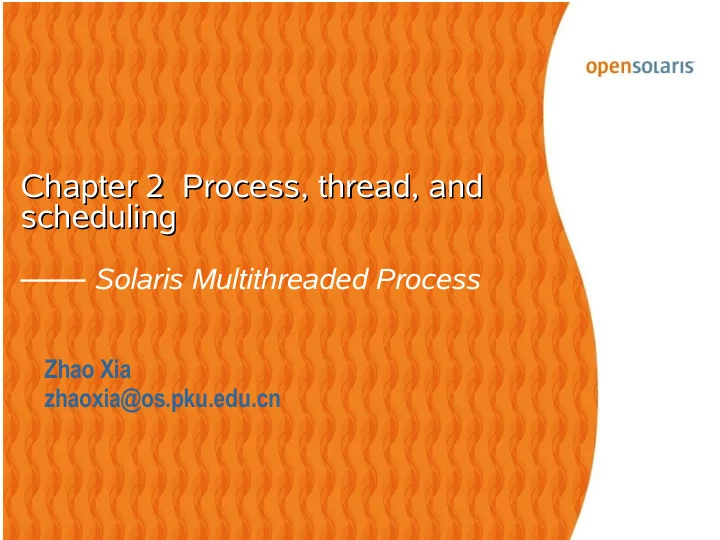

Chapter 2 Process, thread, and Process, thread, and Chapter 2 scheduling scheduling —— Solaris Multithreaded Process Zhao Xia zhaoxia@os.pku.edu.cn
Outline Introduction to Solaris Processes Introduction to Solaris Processes Multithreaded Process Model Proc tools 2
The Process Model Solaris Kernel is Multi-threaded Kernel level threads (kthreads) are the unit of concurrency within the kernel Scheduling, synchronization are kernel-level (kthread) concepts Processes are a combination of state and one or more user threads Process threads are abstracted upon kernel threads Single threaded processes have just one thread 3
The Process Model Processes All processes begin life as a program , a disk file (ELF object) All processes have “state” or context that defines their execution environment - hardware & software context Hardware context The processor state, which is CPU architecture dependent. In general, the state of the hardware registers (general registers, privileged registers) Maintained in the LWP Software context Address space, credentials, open files, resource limits, etc – stuff shared by all the threads in a process can be further divided into “hardware” context and “software” context 4
Conceptual View of a Process 5
Proc structure define the context and execution environment > uarea is embedded in the process structure—it is not maintained as a separate structure. > process kernel Stack in the LWP 6
Process Execution Environment Mapped memory pages for process’s various address space segments Identifiers 7
Process State Diagram For the most part, for each process state, there is a corresponding kthread state Somewhat misleading - kthreads change state, not processes 8
Process and Kernel Thread States Kthread creation is not flagged as a distinct state - they go right to TS_RUN Kthread structures are flagged as TS_FREE when the proc or kthread/LWP is terminated This allows the kernel to maintain a cache of free kthread/LWP structures 9
Process, LWP, and Kthread Linkage Kernel maintains system-wide linked lists of processes, LWPs and kthreads Relationship links maintained at every level 10
Solaris Thread Concepts Kernel Threads Kernel’s unit of concurrency LWP Implemented to allow concurrent system calls from a single process Without LWPs, user threads would contend at system call User Threads The thread abstraction of the userland programming model 11
The Lightweight Process (LWP) the attribute of a LWP Resource utilization counters and microstate accounting information The sum total of all LWPs resource usage is stored in the process Most of the LWP structure members exist to support system calls and to maintain hardware context information An LWP blocked on a system call does not cause the entire process to block 12
The kernel thread (KThread) Features the entity that actually gets put on a dispatch queue and scheduled scheduling class and priority is assigned to a kthread , not the process kthread associated with the LWP, has a priority and scheduling class 13
Outline Introduction to Solaris Processes Multithreaded Process Model Multithreaded Process Model Proc tool 14
Multithreaded Process Model Processes can have varying numbers of user threads, LWPs and kernel threads 15
The Multithreading Revolution 16
Multi-level Thread Model (M:N thread model) Pros: Fast user thread create and destroy No system call required for synchronization Fast context-switching Cons: Complex, and tricky programming model Signal delivery 17
Single-level Thread Model (1:1 Thread Model) Every user level thread has an lwp, and a kthread Kernel level scheduling More expensive thread create/destroy, synchronization More responsive scheduling, synchronization 18
Outline Introduction to Solaris Processes Multithreaded Process Model Proc tool Proc tool 19
proc(1) Debugging Utilities Solaris provides a powerful and unrivaled set of debugging and observation utilities – fully documented in the proc(1) man page. Solaris 10 provides substantial improvements for two of these tools, and a new directory in /proc pmap(1) pfiles(1) /proc/ pid /path 20
pmap(1) Shows information about the address space of a process. 21
pmap(1) May also be used on core files Segments not present in the core files are marked with a '*' 22
Reference Jim Mauro, Richard McDougall, Solaris Internals-Core Kernel Components, Sun Microsystems Press, 2000 Sun, Multithreading in the Solaris Operating Environment, A Technical White Paper,2002 Max Bruning, Threading Model In Solaris, Training lectures,2005 Solaris internals and performance management, Richard McDougall, 2002 23
End • Last.first@Sun.COM 24
Recommend
More recommend